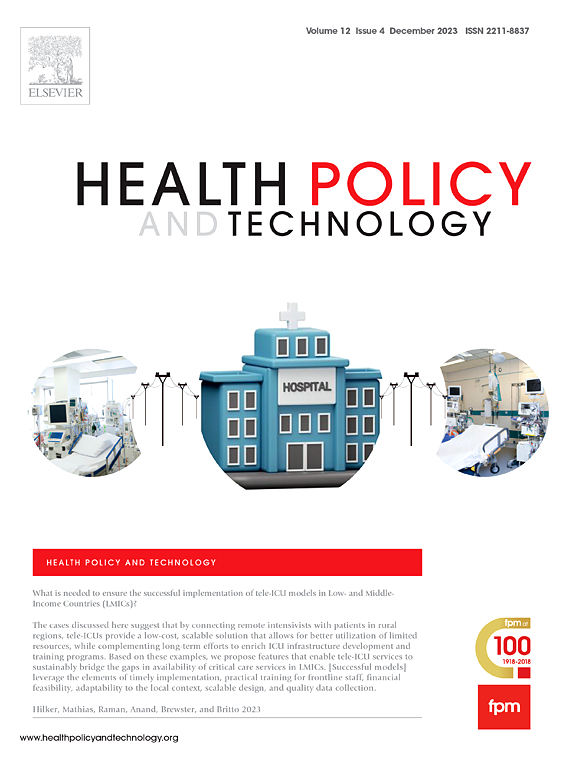Adverse events involving medical devices in Dutch hospitals: A patient record review study
IF 3.7
3区 医学
Q1 HEALTH POLICY & SERVICES
引用次数: 0
Abstract
Objectives
To report the incidence of potentially preventable Adverse Events involving a Medical Device (AEMD) and provide an overview of specific topics on how devices were involved in causing patient harm.
Methods
A retrospective nationwide patient record review study using randomly selected records of 2998 patients deceased during their admission in 20 Dutch hospitals in 2019.
Results
63 potentially preventable AEMDs were identified, corresponding to a weighted incidence of 1.9 % (95CI 1.5 %-2.5 %). Medical devices were involved in about half of all potentially preventable adverse events. Consequences for patients were often severe. Themes in how medical devices were involved in causing patient harm were: Endoscopes causing perforations and hemorrhages, bleedings and infections after placement of heart- and vascular implants, and respiratory harm related to naso- and orogastric tube application. In most cases, the role of the device in causing adverse events was that of prompting a known complication. Preventability in these cases often lied in the subsequent management of the bleeding, perforation or infection.
Conclusions
AEMDs occur in a small percentage of patients admitted and deceased in Dutch hospitals, but do represent a substantial part of all potentially preventable adverse events identified amongst the old and severely comorbid patient group in this study. An additional analysis of the data, provided a more thorough understanding of how the use of medical devices contributes to patient harm. Other study designs are necessary to learn more about technical and organizational issues that might trigger AEMDs.
Public interest summary
Most medical device applications are safe and effective. Though in a small number of cases an Adverse Event involving a Medical Device (AEMD) occurs. This study found that in 1.9 % (95CI 1.5 %-2.5 %) of patients deceased during their admission in 20 Dutch hospitals in 2019 a potentially preventable AEMD occurred. Identified topics in these AEMDs were perforations, bleedings, and infections after application of endoscopes, heart- and vascular implants, and tubes for enteral feeding or drainage. The role of the devices in these AEMDs was often that of prompting a known complication and considered non-preventable. Preventability in most cases lied in the subsequent management of the perforation, bleeding or infection.
荷兰医院中涉及医疗器械的不良事件:一项患者记录回顾研究
目的报告涉及医疗器械(AEMD)的潜在可预防不良事件的发生率,并提供有关器械如何导致患者伤害的特定主题的概述。方法对荷兰20家医院2019年住院期间死亡的2998例患者进行回顾性全国病历回顾研究。结果共发现63例潜在可预防的aemd,加权发生率为1.9% (95CI为1.5% - 2.5%)。在所有可能可预防的不良事件中,约有一半涉及医疗器械。对病人造成的后果往往很严重。医疗器械如何对患者造成伤害的主题是:内窥镜引起穿孔和出血,心脏和血管植入物放置后出血和感染,以及与鼻和胃管应用有关的呼吸伤害。在大多数情况下,器械在引起不良事件中的作用是引起已知的并发症。这些病例的可预防性往往在于出血、穿孔或感染的后续处理。结论:saemd发生在荷兰医院住院和死亡患者中的比例很小,但在本研究中发现的老年和严重合并症患者组中,saemd确实代表了所有潜在可预防的不良事件的很大一部分。对数据的进一步分析使人们对医疗设备的使用如何对患者造成伤害有了更全面的了解。其他研究设计是必要的,以了解更多可能引发aemd的技术和组织问题。大多数医疗器械的应用是安全有效的。虽然在少数情况下会发生涉及医疗器械的不良事件(AEMD)。该研究发现,2019年,在20家荷兰医院住院期间死亡的患者中,有1.9% (95CI 1.5% - 2.5%)发生了潜在的可预防的AEMD。这些aemd确定的主题是应用内窥镜、心脏和血管植入物以及肠内喂养或引流管后的穿孔、出血和感染。这些设备在aemd中的作用通常是引发已知的并发症,并且被认为是不可预防的。在大多数情况下,可预防性在于对穿孔、出血或感染的后续处理。
本文章由计算机程序翻译,如有差异,请以英文原文为准。
求助全文
约1分钟内获得全文
求助全文
来源期刊

Health Policy and Technology
Medicine-Health Policy
CiteScore
9.20
自引率
3.30%
发文量
78
审稿时长
88 days
期刊介绍:
Health Policy and Technology (HPT), is the official journal of the Fellowship of Postgraduate Medicine (FPM), a cross-disciplinary journal, which focuses on past, present and future health policy and the role of technology in clinical and non-clinical national and international health environments.
HPT provides a further excellent way for the FPM to continue to make important national and international contributions to development of policy and practice within medicine and related disciplines. The aim of HPT is to publish relevant, timely and accessible articles and commentaries to support policy-makers, health professionals, health technology providers, patient groups and academia interested in health policy and technology.
Topics covered by HPT will include:
- Health technology, including drug discovery, diagnostics, medicines, devices, therapeutic delivery and eHealth systems
- Cross-national comparisons on health policy using evidence-based approaches
- National studies on health policy to determine the outcomes of technology-driven initiatives
- Cross-border eHealth including health tourism
- The digital divide in mobility, access and affordability of healthcare
- Health technology assessment (HTA) methods and tools for evaluating the effectiveness of clinical and non-clinical health technologies
- Health and eHealth indicators and benchmarks (measure/metrics) for understanding the adoption and diffusion of health technologies
- Health and eHealth models and frameworks to support policy-makers and other stakeholders in decision-making
- Stakeholder engagement with health technologies (clinical and patient/citizen buy-in)
- Regulation and health economics
 求助内容:
求助内容: 应助结果提醒方式:
应助结果提醒方式:


